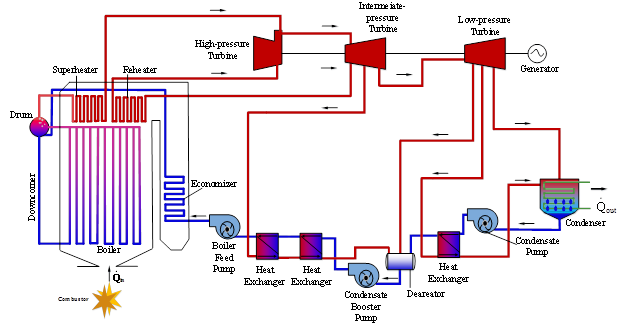

The variable market demand, and the increasing safety and environmental regulations imposed on power plants, force operators to develop dynamic simulation tools, to optimize system operation, scheduling and maintenance, and test control strategies , using test-beds of dynamic models of power plants.1?3 In this work, we explore such simulation environments and in particular the Modelica language and the Thermal Power library of the Dymola software for dynamic simulation, real time optimization and control of a 600 MW subcritical power plant with reheat cycle4 (Fig. 1). The detailed modeling steps, steady-state validation and transient analysis (ramping of load) are discussed. Conventional control designs are also successfully incorporated in the system model. It is shown that the Dymola environment provides a robust test-bed for controller tuning and stability analysis.
Figure 1: Reheat regenerative cycle, 600-MW subcritical-pressure fossil power plant.
The Functional Mockup Interface (FMI) is utilized to bridge the models developed in Dymola with the optimization functionality of Matlab, for the real-time optimization application.5 The target of real-time power plant optimization is to seek for maximum profit/efficiency of the plant by pushing the (steady state) system operating point towards optimum time-varying operating trajectories, while satisfying safety and operability constraints during the transient between steady states. Here, the work flow for dynamic optimization using the FMI Toolbox is presented. The optimization capabilities of the complementary tool chain, which includes Dymola, FMI and Matlab, were successfully demonstrated in case studies of nominal efficiency optimization of the whole plant with respect to admissible plant inputs.
References
1. Lu, S. Dynamic modelling and simulation of power plant systems. Proc. Inst. Mech. Eng. Part A J. Power Energy 213, 7?22 (2005).
2. Lawal, A., Wang, M., Stephenson, P. & Obi, O. Demonstrating full-scale post-combustion CO2 capture for coal-fired power plants through dynamic modelling and simulation. Fuel 101, 115?128 (2012).
3. Lawal, A., Wang, M., Stephenson, P. & Yeung, H. Dynamic modelling of CO2 absorption for post combustion capture in coal-fired power plants. Fuel 88, 2455?2462 (2009).
4. Singer, J. G. Combustion Fossil Power: A Reference Book on Fuel Burning and Steam Generation. (Combustion Engineering, 1991).
5. Åkesson, J., Årzén, K.-E., Gäfvert, M., Bergdahl, T. & Tummescheit, H. Modeling and optimization with Optimica and JModelica.org?Languages and tools for solving large-scale dynamic optimization problems. Comput. Chem. Eng. 34, 1737?1749 (2010).

